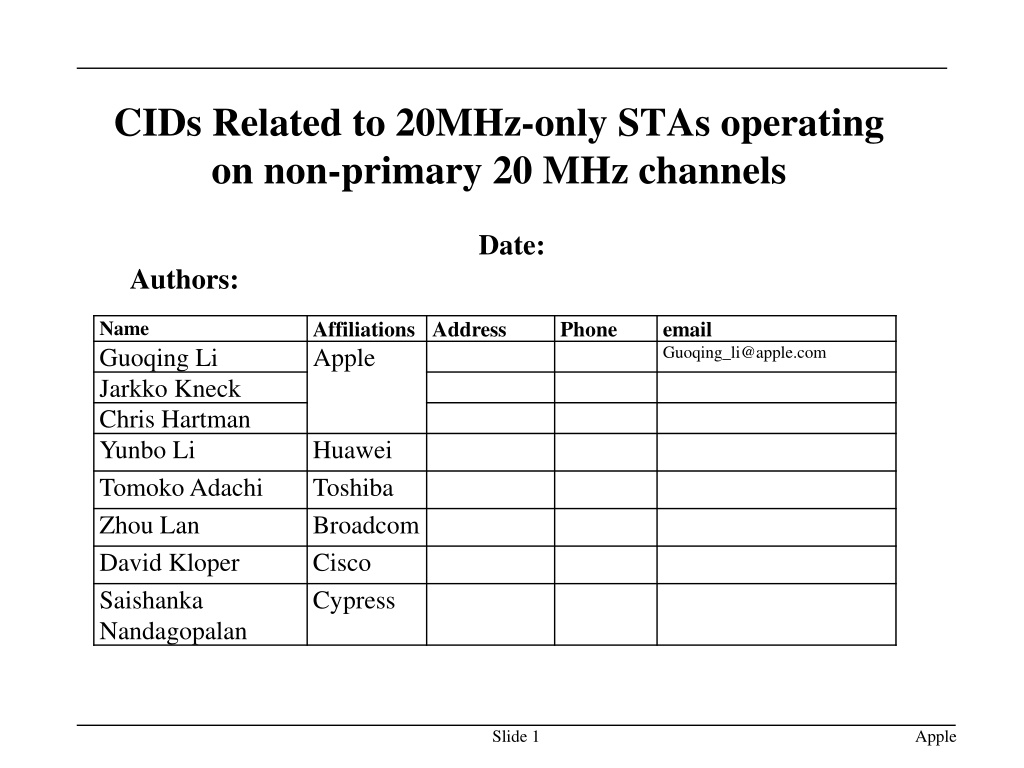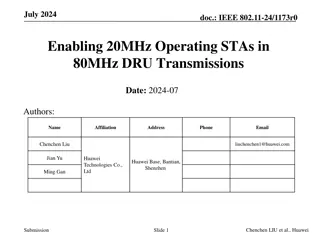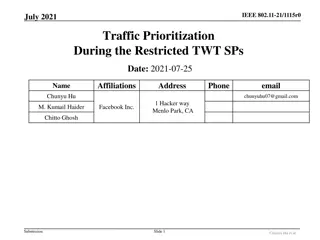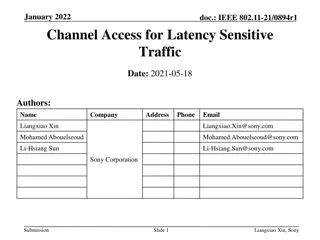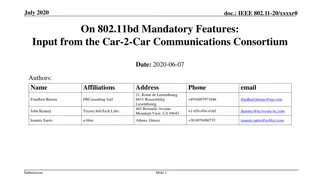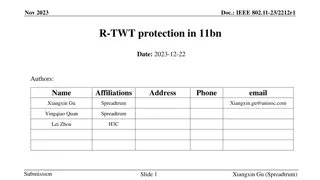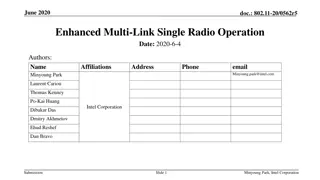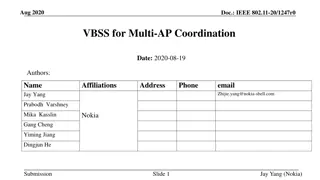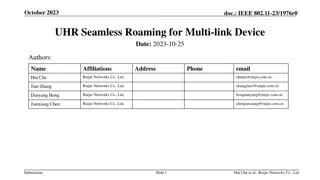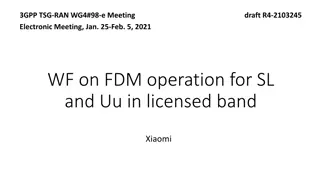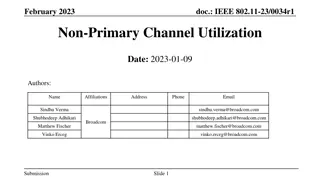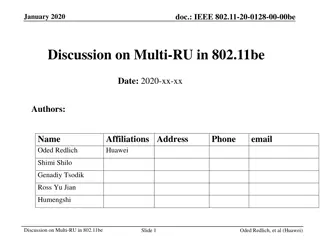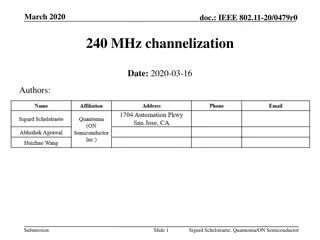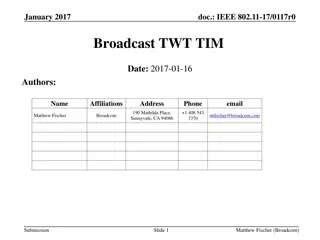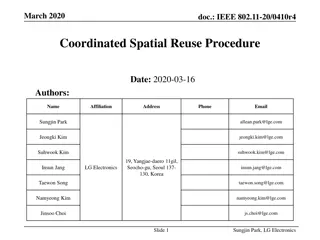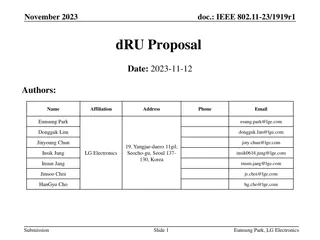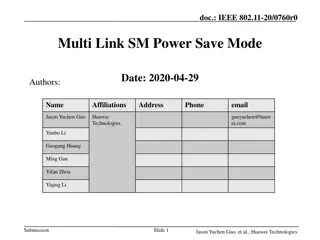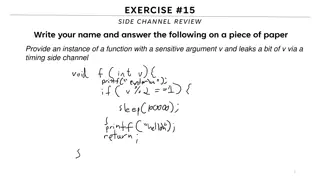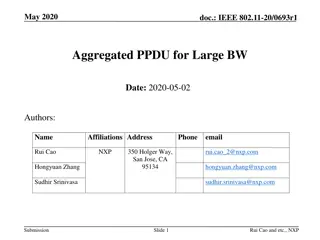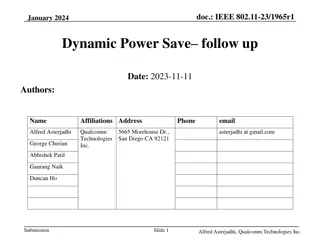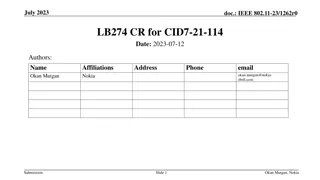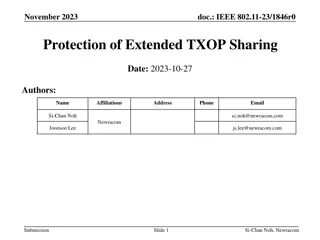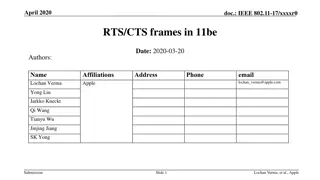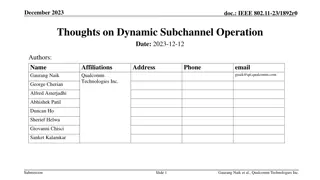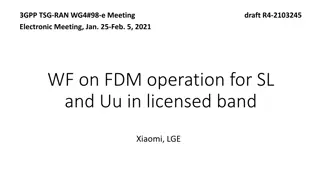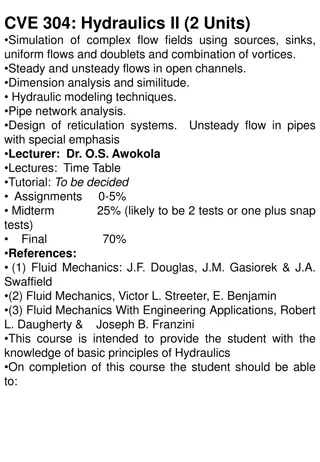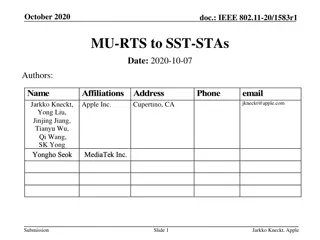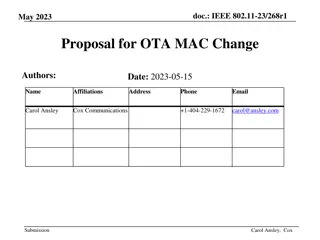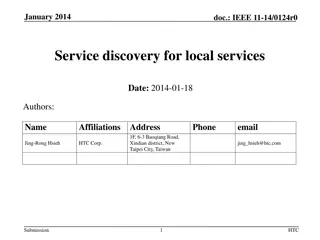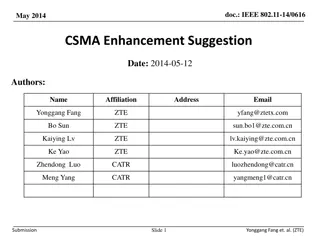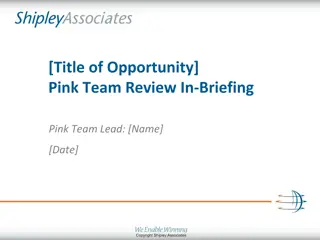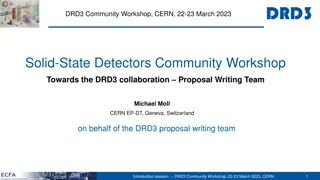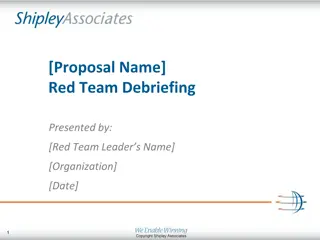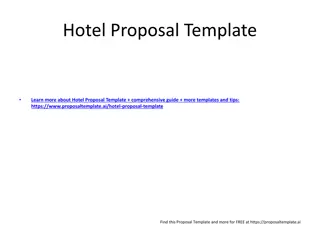Proposal for Enhancing Operation of 20MHz-Only STAs on Non-Primary Channels
The proposal aims to clarify how 20MHz-only STAs can operate on non-primary 20MHz channels, introducing protocol components and considerations for seamless operation. It suggests allowing optional operation on secondary channels and specifies signaling, behavior norms, and capabilities for optimal performance.
Download Presentation

Please find below an Image/Link to download the presentation.
The content on the website is provided AS IS for your information and personal use only. It may not be sold, licensed, or shared on other websites without obtaining consent from the author. Download presentation by click this link. If you encounter any issues during the download, it is possible that the publisher has removed the file from their server.
E N D
Presentation Transcript
CIDs Related to 20MHz-only STAs operating on non-primary 20 MHz channels Date: Authors: Name Guoqing Li Jarkko Kneck Chris Hartman Yunbo Li Tomoko Adachi Zhou Lan David Kloper Saishanka Nandagopalan Affiliations Address Apple Phone email Guoqing_li@apple.com Huawei Toshiba Broadcom Cisco Cypress Slide 1 Apple
Introduction 802.11ax draft 1.0 introduces 20 MHz-only STAs which operate at 20MHz BW only The spec is not clear on whether and how these STAs can operate on non-primary 20MHz channel, see text below This contribution proposes the protocol components and some considerations that will allow these STAs to operate on non-primary 20MHz channel Slide 2 Apple
CIDs Related to 20MHz-only Operation on Secondary Channel The following three CIDs are related to 20MHz-only STA operating on secondary channel 915328.3.3.6 It is not clear on the possibility of the operation in secondary channels from 'primary 20 MHz channel as a mandatory mode' description. Clarify the operation capability on secondary 20MHz channels of 20 MHz-only STA, e.g., only primary 20MHz support or else, and if it is required to operate, define the procedure and signaling. Revised. Propose to allow 20 MHz-operating STA to operate on any 20 MHz. Please see the text for details. 881128.3.3.6 "A 20 MHz only HE STA operates in the primary 20 MHz channel as a mandatory mode." is not correct language for a standard. Revised. Change to "A 20 MHz only HE STA shall only operate in the primary 20 MHz channel." Propose that 20MHz only STA shall support operating on primary channel and may optionally operate on non- primary channels. Please see the proposed text for details 88109.2.4.6.4.3 Current ROM shall be improved to settle the case with large number of STA in narrow band ROM mode. Current ROM requires all STAs to occupy primary 20MHz and causes low channel utility. Need to allocate some narrow band ROM STA to RU in non- primary portion. The Channel Width field shall support indication of specific 20MHz channel which STA prefers in this ROM mode. Agreed in principle. Propose to allow 20 MHz-operating STA to operate on any 20 MHz. Please see the text for details Slide 3 Apple
Proposed Resolution Clarify that 20MHz-only STA can operate on any non-primary 20MHz as an optional mode. This mode can also be used by 80MHz capable STA operating at 20MHz. However, for 80MHz capable STAs, it is better to operate in 80MHz to receive the wideband PPDU Define the protocol elements that allows a 20MHz-only STA to operate on any 20MHz channel Capability indication that a 20MHz-only STA is able to operate on secondary channel Signalings (IE, Action frames etc.) that enable a 20MHz-only STA to switch the operating 20MHz channel Specify the normative behavior for a 20MHz-only STA operating on non-primary 20 MHz channel such as channel access, protection, channel switch delay, Beacon reception and synchronization Slide 4 Apple
Motivation In order for AP to utilize the entire 80 MHz bandwidth, 20MHz-only STA is required to be able to participate in wideband OFDMA An illustration of OFDMA transmission with 20MHz-only STA mixed with 80MHz-STAs 20MHz STA STA8 STA9 STA9 STA7 80MHz STA Secondary 20 STA6 STA5 Note: Secondary 40 is not shown here due to space limitation STA2 STA3 STA1 STA2 Primary 20 STA5 STA3 STA1 STA4 Slide 5 Apple
Motivation (cont.) However, 20MHz-only STAs are envisioned to be low power low complexity devices such as IoT devices In IoT deployment such as home scenarios, a BSS may have a lot of 20MHz- only STAs When these devices only operate on primary 20MHz, the BSS will be forced to operate on primary 20 only and the rest of the 60MHz is wasted most of the time 20MHz STA Note: Secondary 40 is not shown here due to space limitation STA5 80MHz STA Waste of BW when 80MHz STA do not have traffic Secondary 20 STA4 STA1 STA1 STA1 STA2 STA2 STA2 Primary 20 STA3 STA3 STA4 Slide 6 Apple
Solution: Enable 20MHz STAs to Operate on Any 20MHz channel If a STA can operate on any 20MHz channel, then an AP can mix 20MHz STAs with 20MHz STAs in wideband OFDMA, see figure below Compared to the previous slide, channels are utilized more efficiently and flexibly since full BSS BW can be used more often From AP s point of view, this mode allows AP to do intelligent load balancing, interference management and maximize spectrum utilization From STA s point of view, STAs can achieve better power efficiency since no energy is spent on sensing STA4 STA2 STA5 Secondary 20 20MHz STA Note: Secondary 40 is not shown here due to space limitation 80MHz STA STA1 STA1 STA1 STA2 STA2 Primary 20 STA3 STA3 STA4 Apple Apple Slide 7
Channel Access and Protection The STAs staying on non-primary 20MHz channel can only use MU transmission in uplink transmission since it is blind to the status on the primary channel i.e., STAs on secondary channel cannot use EDCA to transmit These devices need to rely on AP for protection DL and UL transmission is recommended to start with MU-RTS and CTS UL transmission is further protected by trigger frame STAs follows the same channel sensing requirement for UL MU operation Slide 8 Apple
Operating Channel Switch A few options to consider Define new IE and new action frames The IE can also be included in (re)association request after STA scans the channel before association Preferred approach Modify TWT channel field in TWT setup It makes more sense for a STA to use TWT when operating on non-primary channel. Since STAs can only do MU in UL transmission on non-primary channel there is no need to be awake all the time, it s better to go to sleep and only wake up at the pre-determined time, i.e., TWT. However, the STA shall not set TWT on non-primary channel if it is already operating on non-primary channel Define new control ID in A-control field or modify OMI However, since operating channel switch for a 20MHz-only STA should take effect only after the switch request is acknowledged, it is more suited to use action frames Slide 9 Apple
Operating Channel Switch (cont.) Both AP and STA should be allowed to initiate channel switch request AP can use the procedure for load balancing and spectrum management STA can use the procedure for interference avoidance and power management STA can provide channel list prioritization based on local measurement Such info can be provided before and after association Before association after scanning the STA should have channel quality info across the band, so defining an IE that can be carried in (re) association request is desired AP should decide the channel for STAs since it has global information across the BSS and can perform global optimization Slide 10 Apple
Operation Timer It is recommended to define a fall-back mechanism so that if the STA does not receive a trigger on the non-primary channel for a long time it can switch back to the primary channel to use regular EDCA Similar to MU EDCA timer, we can define a non-primary channel operation timer for STAs on non-primary channel to switch back to primary channel upon timeout The STA shall send a notification to the AP to inform the channel switch upon time-out after it switches back to primary Any frame that needs acknowledgement sent by the STA can serve this purpose Slide 11 Apple
Channel Switch Time Channel switch takes time and during this period of time, the STA cannot transmit or receive any data STA can provide its channel switch time during association However, how to handle channel switch time can be left to AP s implementation choices A complex AP can take individual STA s channel switch time into account and do things differently with different STAs to maximize channel utilization efficiency A simpler AP may choose to ignore the channel switch time differences to simply its implementation Slide 12 Apple
DL transmission in the absence of traffic on primary channel AP should avoid the possibility that when AP starts DL transmission the buffered DL traffic is only destined for STAs on non-primary channels AP can either group STAs in a way to minimize such possibility or delay the transmission on non-primary channel to wait for traffic on primary channel In case the AP needs to transmit to STAs on non-primary channel only, it shall still transmit preamble on primary channel for protection purposes as required in current spec and leave the data field empty (similar to preamble puncturing) or fill it with dummy bits AP can use the STA ID 2046 in SIG-B User Specific field to indicate the data field is empty (already defined in spec) or use RU allocation 0110001 in SIG-B common part to indicate that the 242 RU is empty or fill the RU with dummy bits using an unallocated STAID Other constraints in draft 1.0 still apply. AP can transmit dummy bits to fill out the RUs across the BW to satisfy this requirements Slide 13 Apple
UL transmission in the absence of traffic on primary channel AP should minimize the possibility of triggering STAs on non-primary channel only Trigger frame shall be non-HT duplicate format if it allocates RUs to STAs on non-primary channel Note that trigger-based PPDU without data on primary channel is possible today when STAs on primary channel do not respond to trigger due to CCA/NAV busy Slide 14 Apple
Beacon Reception and Synchronization STAs on non-primary channels need to receive Beacon to get important operating parameters as well as to synchronize its clock with the AP Since Beacon is transmitted in non-HT format, we have a few options to receive Beacon and multicast AP sends Beacon in non-HT duplicate format violation of baseline spec, confuses legacy STAs AP switches STA back to receive Beacon this requires explicit signaling and can cause high overhead when there are a lot of STAs operating on non-primary channel STA switch back without explicit signaling. AP announces a period in Beacon regarding Slide 15 Apple
Co-existence with OBSS Since STAs operating on non-primary channel does not monitor primary channel, it cannot set NAV by frames transmitted from OBSS which has the same primary channel the BSS However, this case is similar to the case when 11ax regular STAs respond to trigger but the trigger-based PPDU preamble is transmitted only on the 20MHz that contains the RU allocation which can leave primary channel completely empty In addition, such situation already exist today: when OBSS has a different primary channel from own BSS or own BSS has a different channel BW from OBSS and cannot decode and set NAV properly , so Wi-Fi today has to deal with such co- existence too A few mechanisms can be used to improve co-existence STAs can switch back to primary channel when it has not received trigger for longer time STA may choose to scan channels during the operation and report the candidate 20MHz channels AP should scheduling STAs on the candidate 20MHz channels reported from the STA and STA can do some interference measurement in implementation specific manner before and after association Slide 16 Apple
MU-RTS and CTS Currently, MU-RTS and CTS procedure requires that the CTS has to cover primary 20. As a result, AP will consider MU- RTS/CTS success if it receives CTS only on primary channel STAs on non-primary channel can only respond on non-primary channel and thus AP should include STAs on primary channel when triggering STAs on non-primary channel When there is an absence of CTS response on primary 20 due to the reason that either AP did not trigger STAs on primary 20 or STAs on primary channel did not respond to MU-RTS, AP can do the following AP can still use existing rule, i.e., AP still considers MU-RTS failure upon absence of CTS on primary 20, and delayed the transmission to STAs on non-primary channel Or AP can implement extra complexity to check each 20MHz and decide whether to proceed with the following MU transmission This mode of operation can be left to AP s implementation choices Slide 17 Apple
Summary As part of comment resolution for CID 8810, 8811 and 9153, we propose to allow 20MHz-only STAs to operate on any 20MHz channel as an optional mode The protocol considerations to enable such operation are discussed in this contribution Slide 18 Apple
Proposed Spec Text Capability indication (9.4.2.218) Support of non-primary channel operation, Channel Switch Delay field HE Operation Element (9.4..2.219) Added Non-primary Channel Operation Timeout field Channel Switch signaling STA Channel Switch Request/Response element (9.4.2.266, 9.4.2.227) STA Channel Switch Request/response action frames (9.6.30) (Re)Assocation Request/Response (9.3.3.5 - 9.3.3.8) The new IEs are allowed to be included Normative behavior on non-primary channel (27.16.20) STA operation channel switch procedure Channel Access Non-primary channel operation timeout Broadcast and multicast reception Slide 19 Apple
